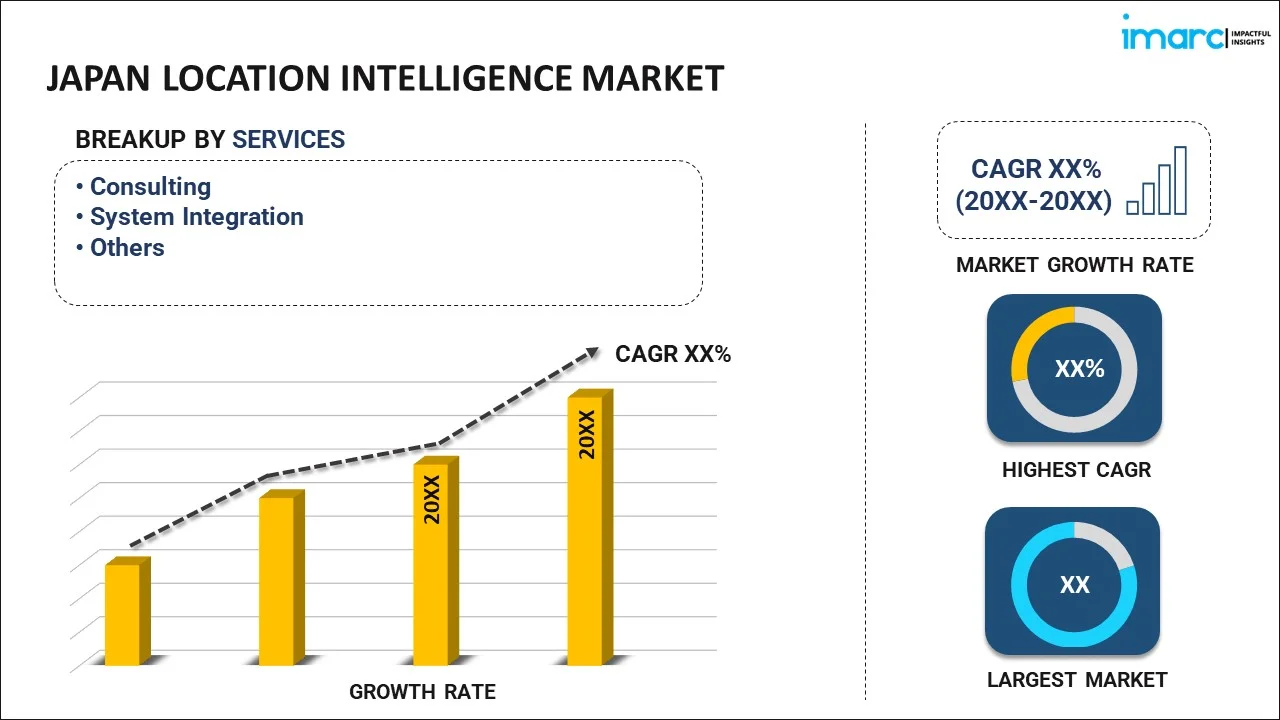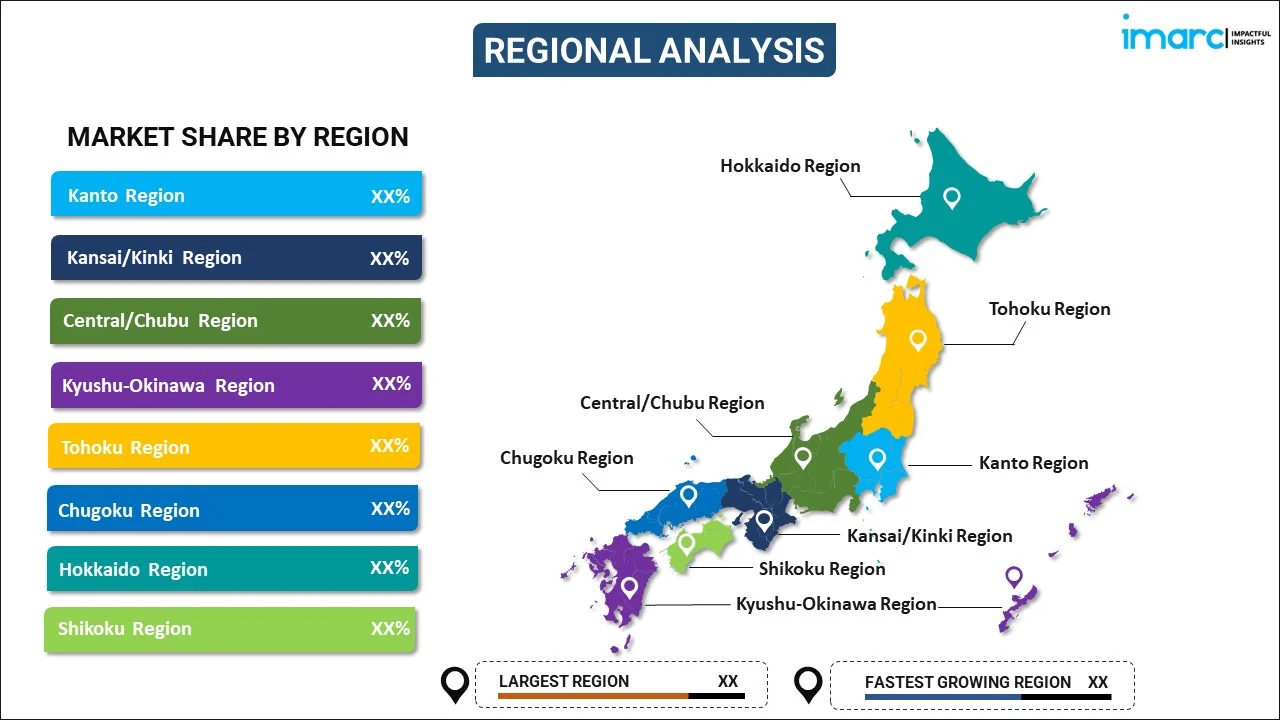
Japan Location Intelligence Market Report by Service (Consulting, System Integration, and Others), Application (Sales and Marketing Optimization, Remote Monitoring, Workforce Management, Asset Management, Facility Management, Risk Management, Customer Management, and Others), End Use Industry (Transportation and Logistics, Retail and Consumer Goods, Government and Defense, Manufacturing and Industrial, IT and Telecom, and Others), and Region 2025-2033
Market Overview:
Japan location intelligence market size reached USD 881.5 Million in 2024. Looking forward, IMARC Group expects the market to reach USD 2,953.4 Million by 2033, exhibiting a growth rate (CAGR) of 13.3% during 2025-2033. The recent advancements in technology, escalating focus on smart cities, presence of numerous tech-savvy enterprises in Japan, significant growth of e-commerce platforms, expanding tourism sector in Japan, and increasing rate of smartphone penetration represent some of the key factors driving the market.
|
Report Attribute
|
Key Statistics
|
|---|---|
|
Base Year
|
2024 |
|
Forecast Years
|
2025-2033
|
|
Historical Years
|
2019-2024
|
| Market Size in 2024 | USD 881.5 Million |
| Market Forecast in 2033 | USD 2,953.4 Million |
| Market Growth Rate (2025-2033) | 13.3% |
Location intelligence refers to the analytical capability that transforms geospatial data into actionable insights. It includes spatial data analytics, geographic information systems (GIS), and mapping-based analytics. Location intelligence is comprised of several components, such as data, analytics software, and visualization tools. It offers numerous features, including real-time tracking, heat mapping, predictive analytics, and geofencing. Location intelligence finds applications across multiple sectors, such as retail site selection, supply chain optimization, transportation management, real estate, emergency response, healthcare, and many more. It enhances decision-making, provides better risk assessment, improves customer targeting, and optimizes resource allocation. In addition to this, location intelligence is known for its cost-effectiveness, efficiency, scalability, accuracy in prediction, and the generation of a holistic view of business operations.
Japan Location Intelligence Market Trends:
The recent advancement in technology and strong infrastructure, which provides an excellent foundation for the adoption of location intelligence tools, is propelling the market growth. Additionally, Japan's robust automotive sector, which benefits from geospatial analytics for supply chain and route optimization, is driving the market growth. Besides this, the escalating focus on smart cities, necessitating the application of location-based data for urban planning and management, is contributing to the market growth. Furthermore, the presence of numerous tech-savvy enterprises in Japan, which is pushing the demand for sophisticated analytics solutions, is catalyzing the market growth. In addition, the significant growth of e-commerce platforms, which use location intelligence for logistics and customer engagement, is stimulating the market growth. Apart from this, the widespread technology utilization in disaster management, owing to the presence of several seismically active regions in Japan, is driving the market growth. Moreover, the expanding tourism sector in Japan, which uses location intelligence for personalized marketing and resource allocation, is bolstering the market growth. Along with this, the increasing rate of smartphone penetration, providing a ready pool of user-generated data for analytics, is driving the market growth. In line with this, the imposition of stringent regulatory compliance in sectors such as healthcare and transportation, which demands accurate record-keeping facilitated by location-based analytics, is strengthening the market growth. Furthermore, the increasing government's focus on digital transformation is acting as another growth-inducing factor. In addition, the rising application of the Internet of Things (IoT) devices in industrial sectors, which offers integration possibilities for location intelligence, is supporting the market growth. Besides this, the heightened environmental concerns, coupled with the need for sustainability, driving the usage of location intelligence in renewable energy projects, are favoring the market growth.
Japan Location Intelligence Market Segmentation:
IMARC Group provides an analysis of the key trends in each segment of the market, along with forecasts at the country level for 2025-2033. Our report has categorized the market based on service, application, and end use industry.
Service Insights:

- Consulting
- System Integration
- Others
The report has provided a detailed breakup and analysis of the market based on the service. This includes consulting, system integration, and others.
Application Insights:
- Sales and Marketing Optimization
- Remote Monitoring
- Workforce Management
- Asset Management
- Facility Management
- Risk Management
- Customer Management
- Others
A detailed breakup and analysis of the market based on the application have also been provided in the report. This includes sales and marketing optimization, remote monitoring, workforce management, asset management, facility management, risk management, customer management, and others.
End Use Industry Insights:
- Transportation and Logistics
- Retail and Consumer Goods
- Government and Defense
- Manufacturing and Industrial
- IT and Telecom
- Others
The report has provided a detailed breakup and analysis of the market based on the end use industry. This includes transportation and logistics, retail and consumer goods, government and defense, manufacturing and industrial, IT and telecom, and others.
Regional Insights:

- Kanto Region
- Kansai/Kinki Region
- Central/ Chubu Region
- Kyushu-Okinawa Region
- Tohoku Region
- Chugoku Region
- Hokkaido Region
- Shikoku Region
The report has also provided a comprehensive analysis of all the major regional markets, which include Kanto Region, Kansai/Kinki Region, Central/ Chubu Region, Kyushu-Okinawa Region, Tohoku Region, Chugoku Region, Hokkaido Region, and Shikoku Region.
Competitive Landscape:
The market research report has also provided a comprehensive analysis of the competitive landscape. Competitive analysis such as market structure, key player positioning, top winning strategies, competitive dashboard, and company evaluation quadrant has been covered in the report. Also, detailed profiles of all major companies have been provided.
Japan Location Intelligence Market Report Coverage:
| Report Features | Details |
|---|---|
| Base Year of the Analysis | 2024 |
| Historical Period | 2019-2024 |
| Forecast Period | 2025-2033 |
| Units | Million USD |
| Scope of the Report | Exploration of Historical and Forecast Trends, Industry Catalysts and Challenges, Segment-Wise Historical and Predictive Market Assessment:
|
| Services Covered | Consulting, System Integration, Others |
| Applications Covered | Sales and Marketing Optimization, Remote Monitoring, Workforce Management, Asset Management, Facility Management, Risk Management, Customer Management, Others |
| End Use Industries Covered | Transportation and Logistics, Retail and Consumer Goods, Government and Defense, Manufacturing and Industrial, IT and Telecom, Others |
| Regions Covered | Kanto Region, Kansai/Kinki Region, Central/ Chubu Region, Kyushu-Okinawa Region, Tohoku Region, Chugoku Region, Hokkaido Region, Shikoku Region |
| Customization Scope | 10% Free Customization |
| Post-Sale Analyst Support | 10-12 Weeks |
| Delivery Format | PDF and Excel through Email (We can also provide the editable version of the report in PPT/Word format on special request) |
Key Questions Answered in This Report:
- How has the Japan location intelligence market performed so far and how will it perform in the coming years?
- What has been the impact of COVID-19 on the Japan location intelligence market?
- What is the breakup of the Japan location intelligence market on the basis of service?
- What is the breakup of the Japan location intelligence market on the basis of application?
- What is the breakup of the Japan location intelligence market on the basis of end use industry?
- What are the various stages in the value chain of the Japan location intelligence market?
- What are the key driving factors and challenges in the Japan location intelligence?
- What is the structure of the Japan location intelligence market and who are the key players?
- What is the degree of competition in the Japan location intelligence market?
Key Benefits for Stakeholders:
- IMARC’s industry report offers a comprehensive quantitative analysis of various market segments, historical and current market trends, market forecasts, and dynamics of the Japan location intelligence market from 2019-2033.
- The research report provides the latest information on the market drivers, challenges, and opportunities in the Japan location intelligence market.
- Porter's five forces analysis assist stakeholders in assessing the impact of new entrants, competitive rivalry, supplier power, buyer power, and the threat of substitution. It helps stakeholders to analyze the level of competition within the Japan location intelligence industry and its attractiveness.
- Competitive landscape allows stakeholders to understand their competitive environment and provides an insight into the current positions of key players in the market.
Need more help?
- Speak to our experienced analysts for insights on the current market scenarios.
- Include additional segments and countries to customize the report as per your requirement.
- Gain an unparalleled competitive advantage in your domain by understanding how to utilize the report and positively impacting your operations and revenue.
- For further assistance, please connect with our analysts.
 Inquire Before Buying
Inquire Before Buying
 Speak to an Analyst
Speak to an Analyst
 Request Brochure
Request Brochure
 Request Customization
Request Customization




.webp)




.webp)












